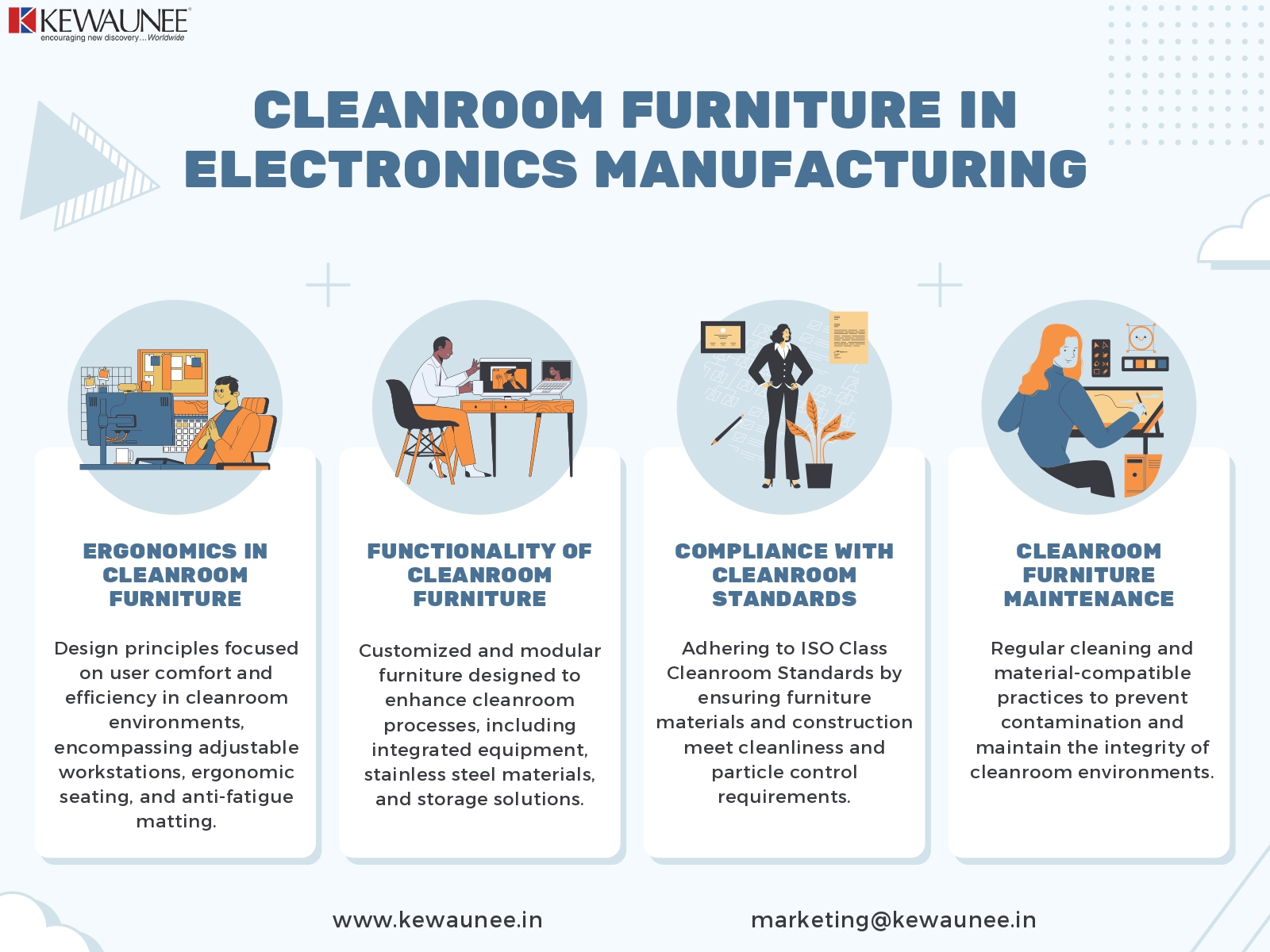Cleanroom Furniture in Electronics Manufacturing
In the highly controlled environment of electronics manufacturing cleanrooms, every element plays a crucial role. Cleanroom furniture, designed with a focus on ergonomics and functionality, contributes significantly to the efficiency and quality of the production process.
This blog delves into the essential role cleanroom furniture plays in electronics manufacturing.
1. Introduction
Electronics manufacturing cleanrooms are designed to minimize contamination, maintain strict environmental controls, and ensure the production of high-quality electronic components.
Cleanroom furniture is an integral part of this ecosystem, designed to meet specific cleanliness and functionality requirements.
2. Ergonomics in Cleanroom Furniture
2.1. Importance of Ergonomics
Ergonomics is the science of designing and arranging things to suit the people who use them. In a cleanroom, ergonomic furniture design is crucial for the comfort and efficiency of operators who spend extended periods working within these controlled environments. Let’s further explore the significance of ergonomics.
Ergonomics is not just about making furniture comfortable; it’s about creating an environment that reduces the risk of injuries, enhances productivity, and ensures operator well-being. In cleanrooms, where operators handle delicate electronic components and work for extended periods, ergonomic furniture is vital.
2.2. Height-Adjustable Workstations
Cleanroom workstations should offer height adjustability to accommodate various operators’ heights. This ensures that the work surface can be set at an optimal level, reducing strain and discomfort. The ability to adjust the workstation’s height is particularly important as it allows operators to work comfortably, whether seated or standing. Ergonomic workstations reduce the risk of musculoskeletal disorders and improve overall productivity.
2.3. Ergonomic Seating
Operators in cleanrooms spend a significant portion of their workday sitting. Ergonomic chairs with proper lumbar support, adjustability, and cushioning are essential for their well-being. Ergonomic seating is designed to provide the necessary support to operators, preventing back pain and discomfort. These chairs can be adjusted to fit individual preferences, ensuring that operators can work for extended periods without experiencing discomfort or strain.
2.4. Anti-Fatigue Matting
Cleanroom floors often have anti-fatigue matting to reduce discomfort during long shifts. These mats help minimize the physical stress on operators. Anti-fatigue mats are designed to provide cushioning, reducing the strain on the legs and back caused by prolonged standing. They improve operator comfort and can contribute to increased productivity and focus.
3. Functionality of Cleanroom Furniture
3.1. Customized Workstations
Cleanroom furniture can be customized to accommodate specific equipment, processes, and operator needs. This includes the integration of equipment racks, shelving, and cable management systems. Customized workstations are designed to optimize the layout of the cleanroom, ensuring that every tool and component has its dedicated space. This reduces clutter, enhances organization, and streamlines the production process.
3.2. Modular Design
Modular cleanroom furniture is designed for adaptability. It allows for reconfiguration as needs change, making it a cost-effective and versatile choice. Modular furniture is designed to be easily rearranged or expanded as the requirements of the cleanroom evolve. This adaptability ensures that the furniture can grow with the cleanroom’s needs, reducing the need for frequent replacements and minimizing disruption to operations.
3.3. Stainless Steel Furniture
Stainless steel is a common choice for cleanroom furniture due to its resistance to corrosion, ease of cleaning, and durability. Stainless steel tables, cabinets, and workstations are ideal for electronics manufacturing cleanrooms. Stainless steel’s properties make it suitable for cleanroom use as it does not shed particles or contaminants that could jeopardize the sensitive electronic components.
3.4. Cleanroom Storage Solutions
Proper storage solutions are essential for keeping cleanrooms organized and efficient. Furniture with integrated storage, such as cabinets and shelving, is vital for electronic components and tools. Cleanroom storage solutions help operators maintain a clutter-free workspace, ensuring that tools and components are easily accessible and organized. This organization contributes to efficient and streamlined production processes.
4. Compliance with Cleanroom Standards
4.1. ISO Class Cleanroom Standards
Cleanroom furniture must comply with ISO classifications that define the cleanliness and particle control of cleanroom environments. This ensures that the furniture itself does not introduce contamination.
Cleanroom furniture should align with the ISO class of the cleanroom where it is used. This alignment guarantees that the furniture meets the cleanliness and particle control requirements specific to that environment.
4.2. Materials and Construction
Furniture materials and construction must meet cleanroom standards, including low particle emission and ease of cleaning to maintain cleanliness. Cleanroom furniture should be constructed using materials that do not release particles or contaminants into the environment. The furniture’s design should facilitate easy cleaning and maintenance to uphold the cleanroom’s standards.
5. Cleanroom Furniture Maintenance
5.1. Regular Cleaning Procedures
Cleanroom furniture should be subjected to strict cleaning procedures to prevent contamination. Routine cleaning helps maintain the integrity of the cleanroom environment. Regular cleaning of cleanroom furniture is necessary to remove any particles or contaminants that may have settled on the surfaces. This routine maintenance is crucial for upholding the cleanroom’s cleanliness and preventing any adverse effects on electronic components.
5.2. Material Compatibility
Cleaning agents used should be compatible with the materials used in cleanroom furniture to prevent any degradation. Choosing the appropriate cleaning agents ensures that the furniture remains in good condition and does not deteriorate over time. Compatibility between the cleaning agents and the furniture materials is essential to prevent any adverse reactions.
Summary
Cleanroom furniture in electronics manufacturing cleanrooms is not just about providing a place to work; it is an essential component of maintaining a controlled and clean environment. Ergonomics ensures the well-being of operators, while functionality allows for efficient processes. Compliance with cleanroom standards and regular maintenance are critical to ensure the furniture’s suitability in these controlled environments.
In conclusion, the role of cleanroom furniture in electronics manufacturing is pivotal. Its design and functionality impact the quality of electronic components and the comfort of those who work within these specialized environments. Cleanroom furniture contributes to the overall success of electronics manufacturing by creating a conducive and efficient workspace that meets the stringent requirements of cleanroom environments.
Comments are closed.











